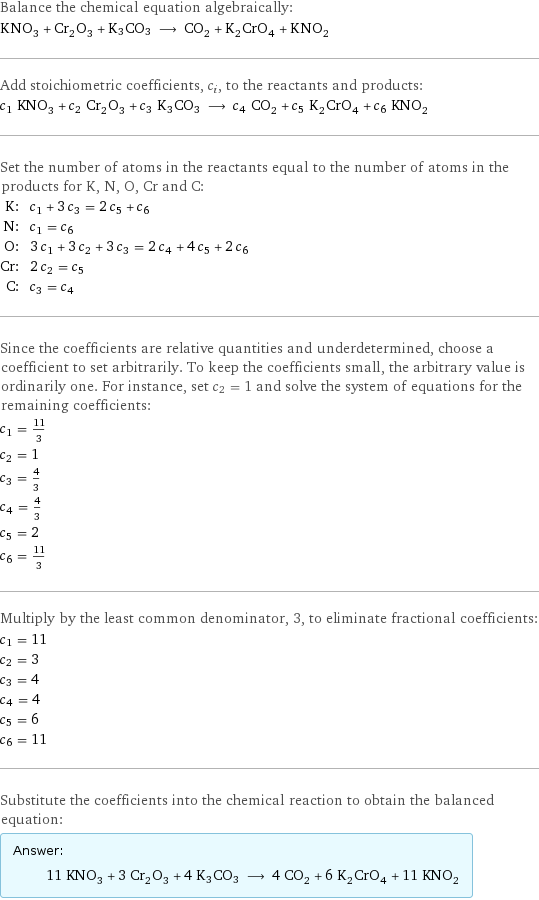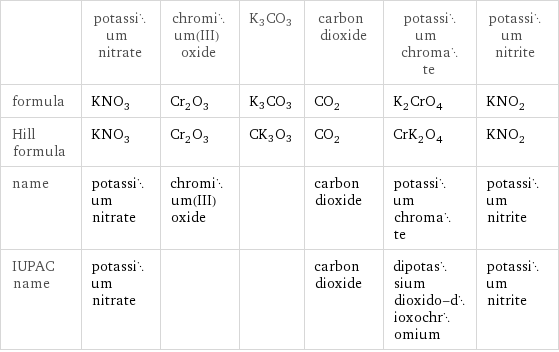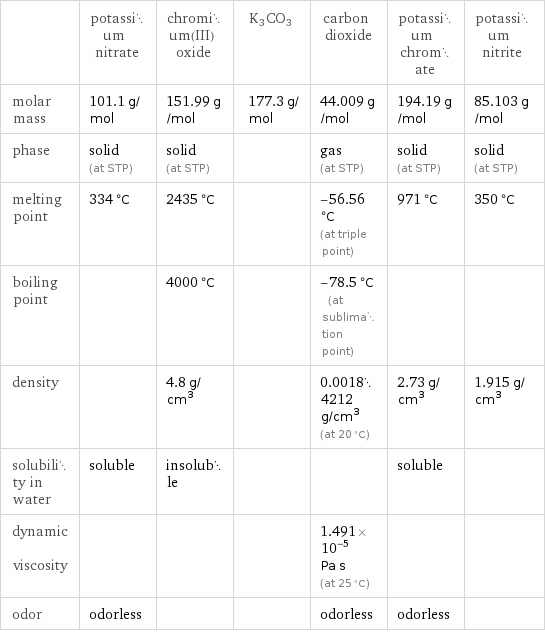Input interpretation

KNO_3 potassium nitrate + Cr_2O_3 chromium(III) oxide + K3CO3 ⟶ CO_2 carbon dioxide + K_2CrO_4 potassium chromate + KNO_2 potassium nitrite
Balanced equation

Balance the chemical equation algebraically: KNO_3 + Cr_2O_3 + K3CO3 ⟶ CO_2 + K_2CrO_4 + KNO_2 Add stoichiometric coefficients, c_i, to the reactants and products: c_1 KNO_3 + c_2 Cr_2O_3 + c_3 K3CO3 ⟶ c_4 CO_2 + c_5 K_2CrO_4 + c_6 KNO_2 Set the number of atoms in the reactants equal to the number of atoms in the products for K, N, O, Cr and C: K: | c_1 + 3 c_3 = 2 c_5 + c_6 N: | c_1 = c_6 O: | 3 c_1 + 3 c_2 + 3 c_3 = 2 c_4 + 4 c_5 + 2 c_6 Cr: | 2 c_2 = c_5 C: | c_3 = c_4 Since the coefficients are relative quantities and underdetermined, choose a coefficient to set arbitrarily. To keep the coefficients small, the arbitrary value is ordinarily one. For instance, set c_2 = 1 and solve the system of equations for the remaining coefficients: c_1 = 11/3 c_2 = 1 c_3 = 4/3 c_4 = 4/3 c_5 = 2 c_6 = 11/3 Multiply by the least common denominator, 3, to eliminate fractional coefficients: c_1 = 11 c_2 = 3 c_3 = 4 c_4 = 4 c_5 = 6 c_6 = 11 Substitute the coefficients into the chemical reaction to obtain the balanced equation: Answer: | | 11 KNO_3 + 3 Cr_2O_3 + 4 K3CO3 ⟶ 4 CO_2 + 6 K_2CrO_4 + 11 KNO_2
Structures

+ + K3CO3 ⟶ + +
Names

potassium nitrate + chromium(III) oxide + K3CO3 ⟶ carbon dioxide + potassium chromate + potassium nitrite
Equilibrium constant
![Construct the equilibrium constant, K, expression for: KNO_3 + Cr_2O_3 + K3CO3 ⟶ CO_2 + K_2CrO_4 + KNO_2 Plan: • Balance the chemical equation. • Determine the stoichiometric numbers. • Assemble the activity expression for each chemical species. • Use the activity expressions to build the equilibrium constant expression. Write the balanced chemical equation: 11 KNO_3 + 3 Cr_2O_3 + 4 K3CO3 ⟶ 4 CO_2 + 6 K_2CrO_4 + 11 KNO_2 Assign stoichiometric numbers, ν_i, using the stoichiometric coefficients, c_i, from the balanced chemical equation in the following manner: ν_i = -c_i for reactants and ν_i = c_i for products: chemical species | c_i | ν_i KNO_3 | 11 | -11 Cr_2O_3 | 3 | -3 K3CO3 | 4 | -4 CO_2 | 4 | 4 K_2CrO_4 | 6 | 6 KNO_2 | 11 | 11 Assemble the activity expressions accounting for the state of matter and ν_i: chemical species | c_i | ν_i | activity expression KNO_3 | 11 | -11 | ([KNO3])^(-11) Cr_2O_3 | 3 | -3 | ([Cr2O3])^(-3) K3CO3 | 4 | -4 | ([K3CO3])^(-4) CO_2 | 4 | 4 | ([CO2])^4 K_2CrO_4 | 6 | 6 | ([K2CrO4])^6 KNO_2 | 11 | 11 | ([KNO2])^11 The equilibrium constant symbol in the concentration basis is: K_c Mulitply the activity expressions to arrive at the K_c expression: Answer: | | K_c = ([KNO3])^(-11) ([Cr2O3])^(-3) ([K3CO3])^(-4) ([CO2])^4 ([K2CrO4])^6 ([KNO2])^11 = (([CO2])^4 ([K2CrO4])^6 ([KNO2])^11)/(([KNO3])^11 ([Cr2O3])^3 ([K3CO3])^4)](../image_source/af08352280f7cc20c9c770435aa3cdfe.png)
Construct the equilibrium constant, K, expression for: KNO_3 + Cr_2O_3 + K3CO3 ⟶ CO_2 + K_2CrO_4 + KNO_2 Plan: • Balance the chemical equation. • Determine the stoichiometric numbers. • Assemble the activity expression for each chemical species. • Use the activity expressions to build the equilibrium constant expression. Write the balanced chemical equation: 11 KNO_3 + 3 Cr_2O_3 + 4 K3CO3 ⟶ 4 CO_2 + 6 K_2CrO_4 + 11 KNO_2 Assign stoichiometric numbers, ν_i, using the stoichiometric coefficients, c_i, from the balanced chemical equation in the following manner: ν_i = -c_i for reactants and ν_i = c_i for products: chemical species | c_i | ν_i KNO_3 | 11 | -11 Cr_2O_3 | 3 | -3 K3CO3 | 4 | -4 CO_2 | 4 | 4 K_2CrO_4 | 6 | 6 KNO_2 | 11 | 11 Assemble the activity expressions accounting for the state of matter and ν_i: chemical species | c_i | ν_i | activity expression KNO_3 | 11 | -11 | ([KNO3])^(-11) Cr_2O_3 | 3 | -3 | ([Cr2O3])^(-3) K3CO3 | 4 | -4 | ([K3CO3])^(-4) CO_2 | 4 | 4 | ([CO2])^4 K_2CrO_4 | 6 | 6 | ([K2CrO4])^6 KNO_2 | 11 | 11 | ([KNO2])^11 The equilibrium constant symbol in the concentration basis is: K_c Mulitply the activity expressions to arrive at the K_c expression: Answer: | | K_c = ([KNO3])^(-11) ([Cr2O3])^(-3) ([K3CO3])^(-4) ([CO2])^4 ([K2CrO4])^6 ([KNO2])^11 = (([CO2])^4 ([K2CrO4])^6 ([KNO2])^11)/(([KNO3])^11 ([Cr2O3])^3 ([K3CO3])^4)
Rate of reaction
![Construct the rate of reaction expression for: KNO_3 + Cr_2O_3 + K3CO3 ⟶ CO_2 + K_2CrO_4 + KNO_2 Plan: • Balance the chemical equation. • Determine the stoichiometric numbers. • Assemble the rate term for each chemical species. • Write the rate of reaction expression. Write the balanced chemical equation: 11 KNO_3 + 3 Cr_2O_3 + 4 K3CO3 ⟶ 4 CO_2 + 6 K_2CrO_4 + 11 KNO_2 Assign stoichiometric numbers, ν_i, using the stoichiometric coefficients, c_i, from the balanced chemical equation in the following manner: ν_i = -c_i for reactants and ν_i = c_i for products: chemical species | c_i | ν_i KNO_3 | 11 | -11 Cr_2O_3 | 3 | -3 K3CO3 | 4 | -4 CO_2 | 4 | 4 K_2CrO_4 | 6 | 6 KNO_2 | 11 | 11 The rate term for each chemical species, B_i, is 1/ν_i(Δ[B_i])/(Δt) where [B_i] is the amount concentration and t is time: chemical species | c_i | ν_i | rate term KNO_3 | 11 | -11 | -1/11 (Δ[KNO3])/(Δt) Cr_2O_3 | 3 | -3 | -1/3 (Δ[Cr2O3])/(Δt) K3CO3 | 4 | -4 | -1/4 (Δ[K3CO3])/(Δt) CO_2 | 4 | 4 | 1/4 (Δ[CO2])/(Δt) K_2CrO_4 | 6 | 6 | 1/6 (Δ[K2CrO4])/(Δt) KNO_2 | 11 | 11 | 1/11 (Δ[KNO2])/(Δt) (for infinitesimal rate of change, replace Δ with d) Set the rate terms equal to each other to arrive at the rate expression: Answer: | | rate = -1/11 (Δ[KNO3])/(Δt) = -1/3 (Δ[Cr2O3])/(Δt) = -1/4 (Δ[K3CO3])/(Δt) = 1/4 (Δ[CO2])/(Δt) = 1/6 (Δ[K2CrO4])/(Δt) = 1/11 (Δ[KNO2])/(Δt) (assuming constant volume and no accumulation of intermediates or side products)](../image_source/a9a216f1c652a451e1cfc0cc9cd6fc49.png)
Construct the rate of reaction expression for: KNO_3 + Cr_2O_3 + K3CO3 ⟶ CO_2 + K_2CrO_4 + KNO_2 Plan: • Balance the chemical equation. • Determine the stoichiometric numbers. • Assemble the rate term for each chemical species. • Write the rate of reaction expression. Write the balanced chemical equation: 11 KNO_3 + 3 Cr_2O_3 + 4 K3CO3 ⟶ 4 CO_2 + 6 K_2CrO_4 + 11 KNO_2 Assign stoichiometric numbers, ν_i, using the stoichiometric coefficients, c_i, from the balanced chemical equation in the following manner: ν_i = -c_i for reactants and ν_i = c_i for products: chemical species | c_i | ν_i KNO_3 | 11 | -11 Cr_2O_3 | 3 | -3 K3CO3 | 4 | -4 CO_2 | 4 | 4 K_2CrO_4 | 6 | 6 KNO_2 | 11 | 11 The rate term for each chemical species, B_i, is 1/ν_i(Δ[B_i])/(Δt) where [B_i] is the amount concentration and t is time: chemical species | c_i | ν_i | rate term KNO_3 | 11 | -11 | -1/11 (Δ[KNO3])/(Δt) Cr_2O_3 | 3 | -3 | -1/3 (Δ[Cr2O3])/(Δt) K3CO3 | 4 | -4 | -1/4 (Δ[K3CO3])/(Δt) CO_2 | 4 | 4 | 1/4 (Δ[CO2])/(Δt) K_2CrO_4 | 6 | 6 | 1/6 (Δ[K2CrO4])/(Δt) KNO_2 | 11 | 11 | 1/11 (Δ[KNO2])/(Δt) (for infinitesimal rate of change, replace Δ with d) Set the rate terms equal to each other to arrive at the rate expression: Answer: | | rate = -1/11 (Δ[KNO3])/(Δt) = -1/3 (Δ[Cr2O3])/(Δt) = -1/4 (Δ[K3CO3])/(Δt) = 1/4 (Δ[CO2])/(Δt) = 1/6 (Δ[K2CrO4])/(Δt) = 1/11 (Δ[KNO2])/(Δt) (assuming constant volume and no accumulation of intermediates or side products)
Chemical names and formulas

| potassium nitrate | chromium(III) oxide | K3CO3 | carbon dioxide | potassium chromate | potassium nitrite formula | KNO_3 | Cr_2O_3 | K3CO3 | CO_2 | K_2CrO_4 | KNO_2 Hill formula | KNO_3 | Cr_2O_3 | CK3O3 | CO_2 | CrK_2O_4 | KNO_2 name | potassium nitrate | chromium(III) oxide | | carbon dioxide | potassium chromate | potassium nitrite IUPAC name | potassium nitrate | | | carbon dioxide | dipotassium dioxido-dioxochromium | potassium nitrite
Substance properties

| potassium nitrate | chromium(III) oxide | K3CO3 | carbon dioxide | potassium chromate | potassium nitrite molar mass | 101.1 g/mol | 151.99 g/mol | 177.3 g/mol | 44.009 g/mol | 194.19 g/mol | 85.103 g/mol phase | solid (at STP) | solid (at STP) | | gas (at STP) | solid (at STP) | solid (at STP) melting point | 334 °C | 2435 °C | | -56.56 °C (at triple point) | 971 °C | 350 °C boiling point | | 4000 °C | | -78.5 °C (at sublimation point) | | density | | 4.8 g/cm^3 | | 0.00184212 g/cm^3 (at 20 °C) | 2.73 g/cm^3 | 1.915 g/cm^3 solubility in water | soluble | insoluble | | | soluble | dynamic viscosity | | | | 1.491×10^-5 Pa s (at 25 °C) | | odor | odorless | | | odorless | odorless |
Units
